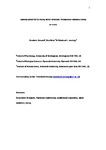Learning About the CS During Latent Inhibition: Preexposure Enhances Temporal Control
| dc.contributor.author | Bonardi, C | |
| dc.contributor.author | Brilot, Ben | |
| dc.contributor.author | Jennings, DJ | |
| dc.date.accessioned | 2016-06-10T13:25:09Z | |
| dc.date.available | 2016-06-10T13:25:09Z | |
| dc.date.issued | 2016-04 | |
| dc.identifier.issn | 0097-7403 | |
| dc.identifier.issn | 2329-8464 | |
| dc.identifier.uri | http://hdl.handle.net/10026.1/4881 | |
| dc.description.abstract |
In 3 experiments, rats were given nonreinforced preexposure to an auditory stimulus, after which this stimulus and a second, novel cue were paired with food. Lower rates of conditioned responding were observed to the preexposed stimulus across the 3 experiments, indicative of latent inhibition. The degree to which animals used these cues to time the occurrence of food delivery was also examined. Paradoxically, the response slopes—indicating the rate of increase in responding over the course of the conditioned stimulus—were greater for the preexposed than for the novel cues, consistent with the suggestion that the preexposed stimulus exerted greater temporal control. Moreover, this was the case irrespective of whether the duration of the cue during preexposure differed from that during conditioning. These results suggest that although conditioned stimulus preexposure retards conditioning, it may enhance timing. The findings are discussed in terms of current models of conditioning and timing. | |
| dc.format.extent | 187-199 | |
| dc.format.medium | Print-Electronic | |
| dc.language | en | |
| dc.language.iso | en | |
| dc.publisher | American Psychological Association (APA) | |
| dc.subject | association formation | |
| dc.subject | conditioned responding | |
| dc.subject | latent inhibition | |
| dc.subject | Pavlovian conditioning | |
| dc.subject | timing | |
| dc.title | Learning About the CS During Latent Inhibition: Preexposure Enhances Temporal Control | |
| dc.type | journal-article | |
| dc.type | Journal Article | |
| dc.type | Research Support, Non-U.S. Gov't | |
| plymouth.author-url | http://gateway.webofknowledge.com/gateway/Gateway.cgi?GWVersion=2&SrcApp=PARTNER_APP&SrcAuth=LinksAMR&KeyUT=WOS:000373965700005&DestLinkType=FullRecord&DestApp=ALL_WOS&UsrCustomerID=11bb513d99f797142bcfeffcc58ea008 | |
| plymouth.issue | 2 | |
| plymouth.volume | 42 | |
| plymouth.publication-status | Published | |
| plymouth.journal | JOURNAL OF EXPERIMENTAL PSYCHOLOGY-ANIMAL LEARNING AND COGNITION | |
| dc.identifier.doi | 10.1037/xan0000096 | |
| plymouth.organisational-group | /Plymouth | |
| plymouth.organisational-group | /Plymouth/Faculty of Science and Engineering | |
| plymouth.organisational-group | /Plymouth/REF 2021 Researchers by UoA | |
| plymouth.organisational-group | /Plymouth/REF 2021 Researchers by UoA/UoA04 Psychology, Psychiatry and Neuroscience | |
| dc.publisher.place | United States | |
| dcterms.dateAccepted | 2015-12-11 | |
| dc.identifier.eissn | 2329-8464 | |
| dc.rights.embargoperiod | No embargo | |
| rioxxterms.versionofrecord | 10.1037/xan0000096 | |
| rioxxterms.licenseref.uri | http://www.rioxx.net/licenses/all-rights-reserved | |
| rioxxterms.licenseref.startdate | 2016-04 | |
| rioxxterms.type | Journal Article/Review |


